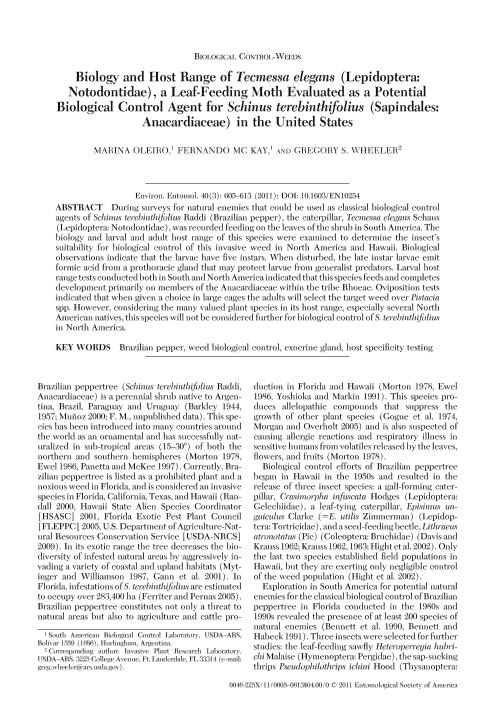Artículo
Biology and host range of Tecmessa elegans (Lepidoptera: Notodontidae), a leaf-feeding moth evaluated as a potential biological control agent for Schinus terebinthifolius (Sapindales: Anacardiaceae) in the United States
Fecha de publicación:
06/2011
Editorial:
Oxford University Press
Revista:
Environmental Entomology
ISSN:
0046-225X
Idioma:
Inglés
Tipo de recurso:
Artículo publicado
Clasificación temática:
Resumen
During surveys for natural enemies that could be used as classical biological control agents of Schinus terebinthifolius Raddi (Brazilian pepper), the caterpillar, Tecmessa elegans Schaus (Lepidoptera: Notodontidae), was recorded feeding on the leaves of the shrub in South America. The biology and larval and adult host range of this species were examined to determine the insect's suitability for biological control of this invasive weed in North America and Hawaii. Biological observations indicate that the larvae have five instars. When disturbed, the late instar larvae emit formic acid from a prothoracic gland that may protect larvae from generalist predators. Larval host range tests conducted both in South and North America indicated that this species feeds and completes development primarily on members of the Anacardiaceae within the tribe Rhoeae. Oviposition tests indicated that when given a choice in large cages the adults will select the target weed over Pistacia spp. However, considering the many valued plant species in its host range, especially several North American natives, this species will not be considered further for biological control of S. terebinthifolius in North America.
Archivos asociados
Licencia
Identificadores
Colecciones
Articulos(IFEVA)
Articulos de INST.D/INV.FISIOLOGICAS Y ECO.VINCULADAS A L/AGRIC
Articulos de INST.D/INV.FISIOLOGICAS Y ECO.VINCULADAS A L/AGRIC
Citación
Oleiro, Marina Ines; Mc Kay, Fernando; Wheeler, Gregory; Biology and host range of Tecmessa elegans (Lepidoptera: Notodontidae), a leaf-feeding moth evaluated as a potential biological control agent for Schinus terebinthifolius (Sapindales: Anacardiaceae) in the United States; Oxford University Press; Environmental Entomology; 40; 3; 6-2011; 605-613
Compartir
Altmétricas




